Keep your sun kitchen equipment safe with regular inspections and proper maintenance protocols. You'll need to conduct routine site surveys, check for hazards, and guarantee your panels are clean and properly ventilated. Monitor cooking temperatures between 200-300°F using reliable thermostats, and always wear appropriate PPE including heat-resistant gloves and non-slip shoes. Don't forget to establish clear emergency shutdown procedures and maintain easy access to gas control measures. Position your kitchen to maximize sun exposure while considering natural shade options. The deeper you explore these safety measures, the more confidence you'll gain in your solar cooking setup.
Regular Solar Equipment Assessment
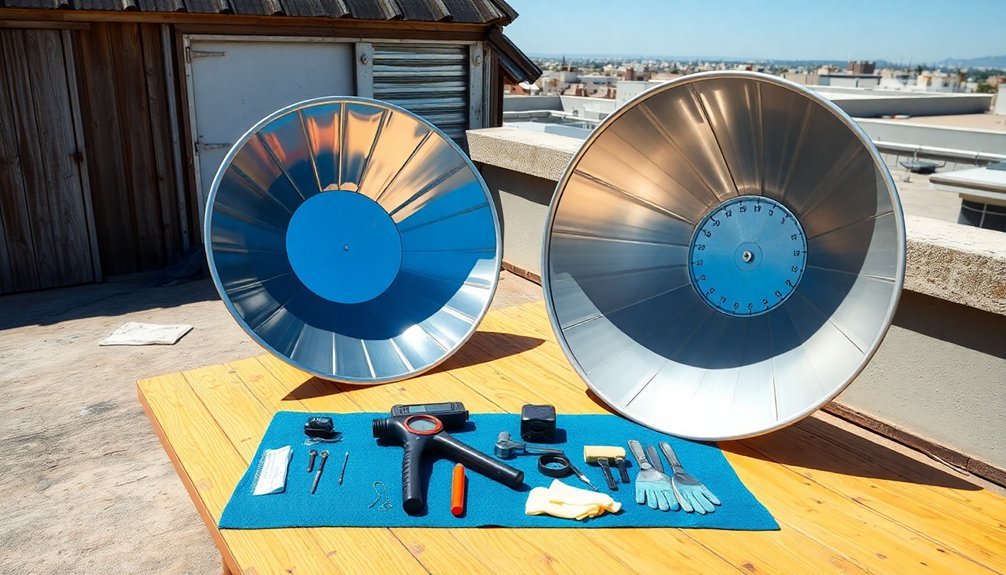
When maintaining solar kitchen equipment, regular assessments serve as your first line of defense against potential hazards and system failures.
You'll need to evaluate your site's geographic location and guarantee your installation area, whether it's the roof or ground, meets structural requirements.
Check your roof's tilt, size, and type if you've opted for rooftop installation. You must identify any obstructions or shading elements that could affect your system's performance.
Don't overlook potential hot spots, as these can trigger fire outbreaks. Keep your system's components free from shade and guarantee proper ventilation. Ensure your solar kitchen appliances are positioned away from sinks to prevent electrical hazards.
Follow the manufacturer's instructions during inspections and wear appropriate protective gear.
Make it a habit to conduct routine site surveys, identifying and addressing potential hazards before they become serious issues.
Temperature Control Mechanisms
To maintain safe and effective solar cooking, proper temperature control mechanisms form the cornerstone of your kitchen operations.
Utilizing capillary thermostats provides reliable temperature management across your cooking equipment. You'll need to monitor internal temperatures between 150°F and 400°F using Type-K thermocouples and digital thermometers for precise readings. During peak hours (11:00 am to 3:00 pm), track temperatures more frequently and adjust cooking times accordingly.
- You're protecting your family's health by consistently monitoring food temperatures – don't let unsafe cooking put loved ones at risk.
- You're mastering nature's power when you adjust cooking methods based on available sunlight.
- You're becoming self-sufficient as you learn to read and respond to temperature fluctuations like a pro.
Remember to preheat your solar oven for an hour before cooking, and use dark-colored, lidded cookware to maximize heat retention and guarantee consistent cooking temperatures.
Solar Panel Cleaning Protocol
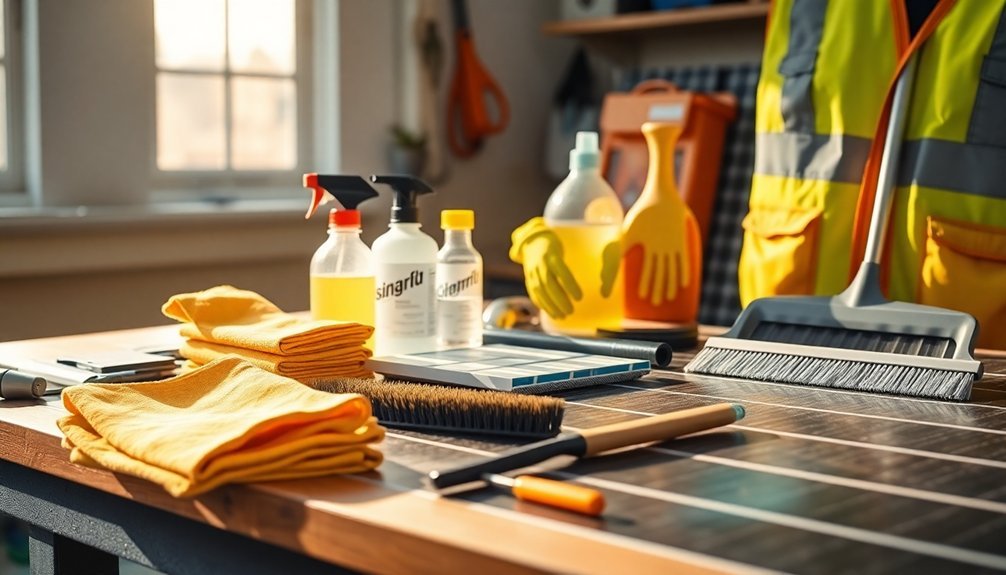
A proper cleaning protocol serves as your first line of defense in maintaining efficient solar kitchen equipment. Before starting, turn off your system and gather the right tools: a soft-bristle brush, mild biodegradable soap, and a gentle-flow hose. Don't use harsh chemicals or pressure washers that could damage your panels. Working with a partner is recommended for maximum safety during the cleaning process.
| Safety Do's | Safety Don'ts |
|---|---|
| Wear rubber-soled shoes | Walk on panels |
| Use soft brushes only | Clean during peak heat |
| Follow temperature guidelines | Use pressure washers |
When cleaning, gently scrub the surface with your long-handled brush and rinse with temperature-matched water. For stubborn spots, use a soft cloth with mild detergent. You'll want to schedule cleanings after winter and summer when buildup is highest. Consider professional services for thorough maintenance, or explore automated cleaning systems to reduce risk and enhance safety.
Heat Storage Safety Guidelines
Since safe heat storage directly impacts cooking effectiveness and food safety, understanding proper temperature control is essential for solar kitchen operations.
You'll need to maintain temperatures between 200-300°F while cooking and guarantee food reaches an internal temperature of at least 180°F. Keep your food out of the danger zone (50-125°F) by using insulated containers and dark-colored, tight-fitting lids.
- Your family's health depends on proper temperature monitoring – don't skip regular thermometer checks
- The satisfaction of serving safely cooked meals starts with maintaining consistent heat levels
- Your peace of mind comes from knowing you've followed proper heat storage protocols
Remember to minimize opening the oven door and use reflectors effectively to maintain ideal cooking temperatures.
Test your cooker's heat retention capabilities regularly and adjust positioning based on sunlight conditions.
Reflector Surface Maintenance
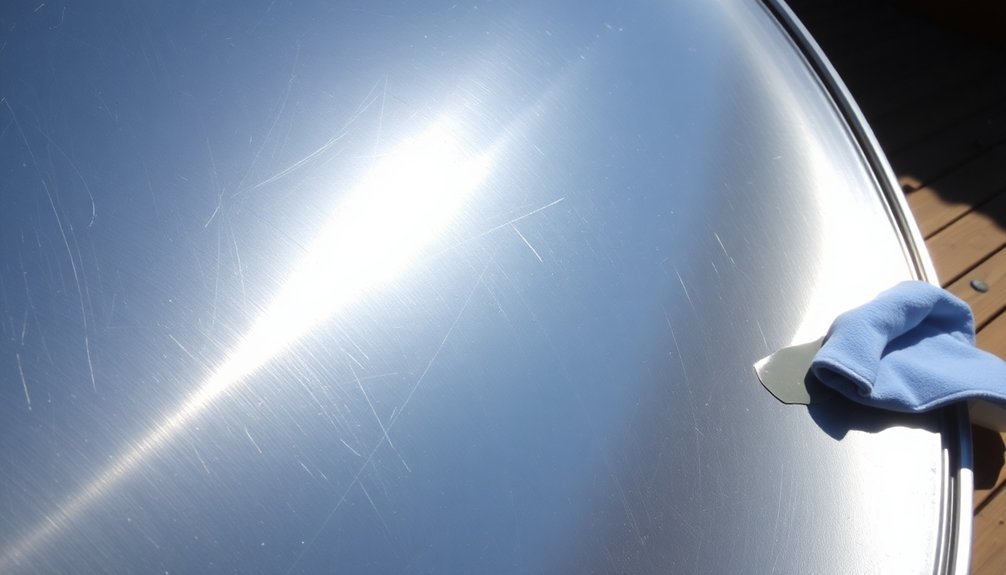
Maintaining ideal cooking temperatures requires pristine reflector surfaces on your Sun Oven equipment.
You'll need to clean your reflectors using non-abrasive solutions like Windex, vinegar, or water. Don't use alcohol, as it can damage the finish and leave white lines.
For regular maintenance, wipe down reflectors after each use with a microfiber cloth, and perform thorough cleaning every 3-4 months.
When dealing with stubborn spots, use compressed air or a camera sensor cleaning swab kit. Always avoid touching the reflector surface directly to prevent fingerprints.
During cleaning, use distilled water to prevent mineral residue, and dry thoroughly with compressed air or a dust blower.
Don't use canned air containing propane-butane, as it leaves residue. Remember to realign your Sun Oven every 30 minutes during cleaning sessions.
Protective Equipment Requirements
When operating sun kitchen equipment, proper protective gear serves as your first line of defense against burns, cuts, and other workplace hazards.
You'll need to wear heat-resistant gloves when handling hot surfaces, non-slip shoes to maintain stability, and appropriate head covering to guarantee hygiene standards.
Don't forget to protect your body with well-fitted aprons and clothing made from non-flammable materials.
- You can't afford to skip wearing safety glasses or face shields – one splash of hot liquid could lead to devastating eye injuries.
- Your hands are your most valuable tools – protect them with cut-resistant gloves when handling sharp objects.
- Don't underestimate the importance of proper footwear – a single slip while carrying hot equipment could result in severe burns.
Weather Protection Measures
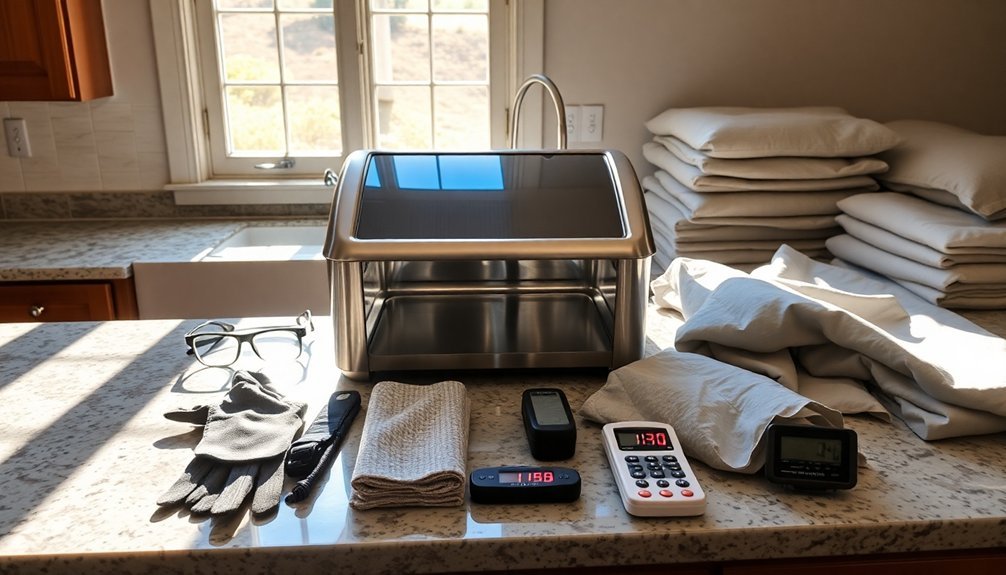
Your outdoor kitchen needs proper shelter with durable covers and roofing to shield equipment from rain, which can cause rust and electrical hazards.
To guard against harsh sunlight, you'll want to install UV-protective covers and strategic shading solutions that prevent damage to surfaces and components.
You should also maintain consistent temperature control through insulated covers and proper ventilation systems, helping to protect your equipment during extreme weather conditions.
Shelter From Rain Damage
Proper shelter from rain damage stands as a critical component in protecting outdoor kitchen equipment and extending its lifespan.
You'll need high-quality covers made from weather-resistant materials like polyester or vinyl to shield your investment.
Don't forget to verify your covers include UV protection and ventilation flaps to prevent condensation buildup and rust.
For thorough protection, consider installing modular roofing or retractable aluminum slats with integrated drainage channels.
During winter months, it's important to deep clean all surfaces and disconnect water supplies to prevent freezing damage.
- Your outdoor kitchen is more than equipment – it's where memories are made
- Every raindrop prevented today saves costly repairs tomorrow
- Protection isn't just about covers – it's about preserving your outdoor sanctuary
Sunlight Exposure Prevention
Protecting outdoor kitchen equipment from harsh sunlight requires strategic planning and proper protective measures.
You'll want to invest in high-quality covers made from UV-resistant polyester or vinyl, ensuring they fit snugly and include ventilation flaps to prevent moisture buildup.
Position your outdoor kitchen strategically by considering peak sun hours and natural shade from mature trees.
When selecting materials, opt for weather-resistant options like stainless steel, concrete, or properly stained wood. Your countertops should be UV-resistant to prevent discoloration.
Don't forget regular maintenance – clean your equipment after each use and inspect for sun damage regularly.
Install awnings or permanent roofing for additional protection, and store sensitive items indoors when they're not in use.
These steps will help extend your outdoor kitchen's life and maintain its appearance.
Temperature Control Systems
While outdoor kitchen equipment faces various weather challenges, implementing robust temperature control systems is crucial for maintaining safe operations.
You'll need to monitor both collector and storage tank temperatures through a backlit LCD display that shows real-time readings in your preferred unit (°C/°F). The system's safety features, including stagnation protection and anti-freeze functions, work automatically to prevent damage from extreme temperatures.
- Don't risk your equipment's safety – regularly verify sensor connections and check for T1/T2 errors that could compromise temperature readings.
- Keep your family protected by confirming the over-temperature disconnection and freeze protection systems are always functional.
- Save yourself from costly repairs by maintaining proper ventilation and conducting periodic system checks.
Program your maximum tank temperatures and enable the holiday function when you're away to guarantee continuous protection.
Emergency Shutdown Procedures
You'll need to know the essential shutdown sequence to protect your kitchen during emergencies, starting with turning off all active cooking equipment.
Your next vital step is to locate and shut off the main gas supply valve, which prevents dangerous gas accumulation during a crisis.
Finally, you must identify and activate the emergency power stops at key locations throughout your kitchen to completely cut electrical flow to all equipment.
Critical Shutdown Steps First
When faced with an emergency in your commercial kitchen, knowing the immediate shutdown sequence can prevent accidents and equipment damage.
You'll need to act swiftly and methodically to safeguard your kitchen equipment and protect your staff.
- Cut off all power and gas immediately – Turn off and unplug all equipment from their power sources, and shut down all gas supplies to prevent fire hazards or explosions.
- Secure hot equipment and oils – Safely drain hot oils from fryers into appropriate containers, and guarantee all hot surfaces are properly cooled down to prevent burns or fires.
- Protect water-based systems – Turn off all water shut-off valves, drain water from dishwashers, steamers, and beverage lines to prevent flooding and bacterial growth.
Remember to keep your emergency shutdown procedures posted where all staff can easily access them.
Gas Supply Control Protocol
Since gas-related emergencies demand swift action, understanding proper gas supply control protocols is essential for every commercial kitchen.
You'll need an Emergency Isolation Valve (EIV) or emergency stop button installed on your kitchen's gas supply system, positioned near the kitchen exit or outside the building for quick access.
Ensure all staff can readily reach the emergency controls and recognize the safety notice displayed beside them. Your team must receive proper training on activating these emergency measures.
Regular inspection of gas solenoid valves is vital – check for wear and tear while maintaining compliance with OSHA standards. Make sure a qualified professional handles the installation and maintenance of these safety systems.
Don't forget to implement an interlock system that automatically shuts off gas flow when ventilation becomes inadequate.
Power Emergency Stop Points
Three critical components form the foundation of an effective emergency shutdown system: integration with suppression systems, electrical shut-off mechanisms, and manual activation points.
You'll need to guarantee your kitchen's emergency stop points are strategically placed and clearly marked for immediate access during crisis situations. Regular maintenance and testing of these systems will keep your staff and equipment protected while maintaining compliance with safety regulations.
- Your staff's lives could depend on quick access to emergency shut-off switches – place them where they're visible and reachable.
- Don't risk catastrophic equipment damage – integrate your shutdown mechanisms with fire suppression systems for automated response.
- When seconds count, you can't afford confusion – post clear protocols and train your staff regularly on manual shutdown procedures.
Frequently Asked Questions
How Often Should Calibration Checks Be Performed on Sun-Tracking Sensors?
You'll need to calibrate sun-tracking sensors daily for basic checks, weekly for detailed alignment verification, and monthly for thorough calibration. Regular maintenance guarantees peak tracking accuracy and performance of your sensors.
What Are the Safe Humidity Levels for Operating Solar Kitchen Equipment?
You don't need specific humidity levels for solar kitchen equipment, but you'll want to minimize condensation. Monitor moisture buildup and ventilate steam regularly by briefly opening the oven door during cooking.
Can Solar Cookers Be Used Safely During Partial Cloud Coverage?
You can safely use solar cookers during partial clouds, but you'll need to make adjustments. Use heat-trapping bags, maintain constant monitoring, and expect longer cooking times. Always follow standard safety precautions.
What Is the Maximum Wind Speed for Safe Operation?
You shouldn't operate in winds above 30 mph, following OSHA guidelines. For solar equipment, you'll want to stop at even lower speeds since wind can destabilize reflectors and affect cooking performance.
How Do Seasonal Changes Affect Maintenance Schedules for Solar Kitchen Equipment?
You'll need to adjust your cleaning frequency based on seasonal debris: more often in spring/fall for pollen and leaves, and during dusty summers. Winter requires snow removal and checking for ice damage.
In Summary
Your sun kitchen's safety depends on consistent attention to these essential checkpoints. Don't skip regular maintenance, and you'll guarantee your solar cooking equipment remains both efficient and safe. Keep this checklist handy, follow the safety protocols, and you'll be able to harness solar energy for cooking with confidence. Remember, proper care of your equipment isn't just about performance—it's about protecting you and your family.


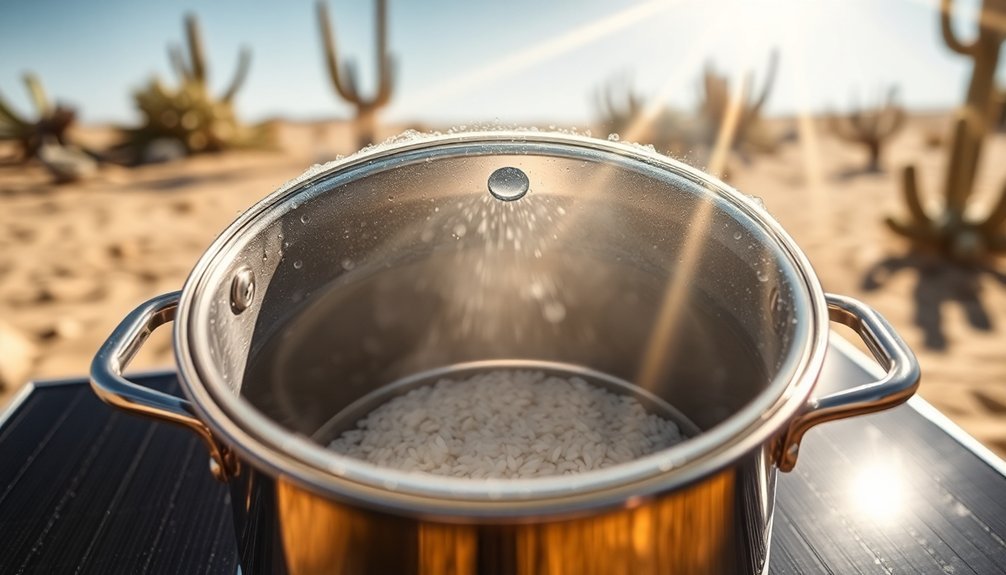
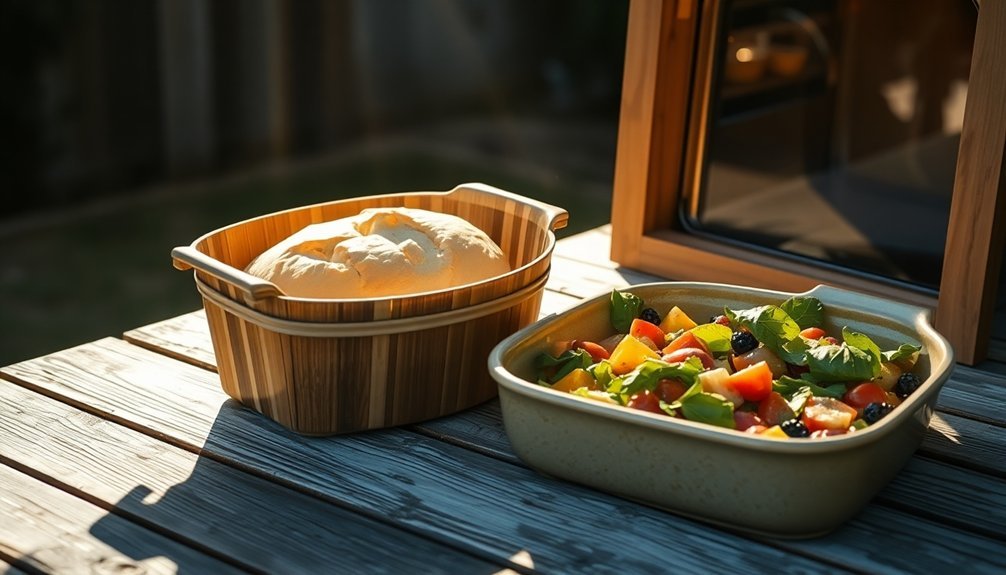
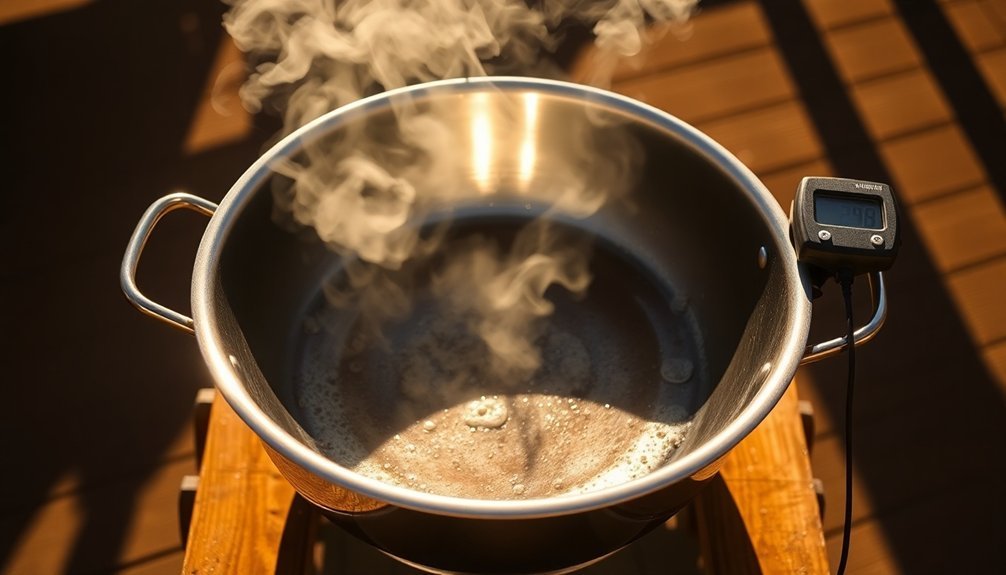
Leave a Reply